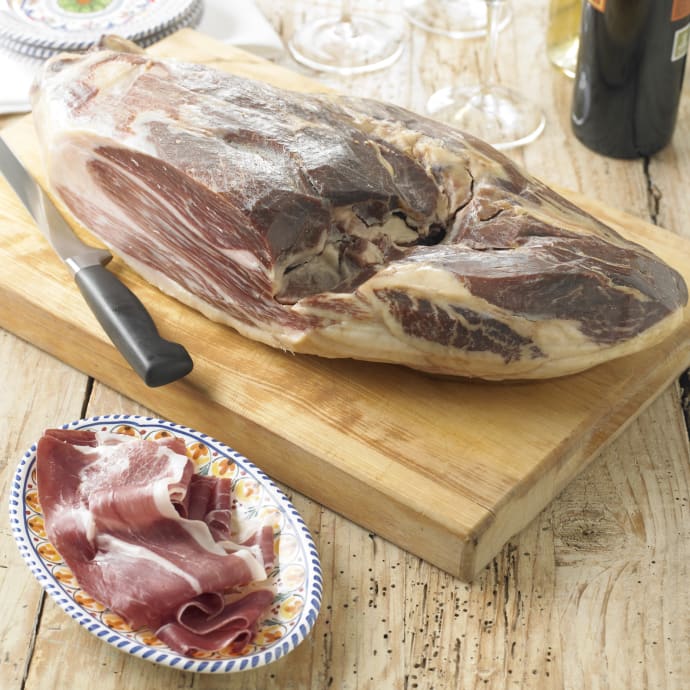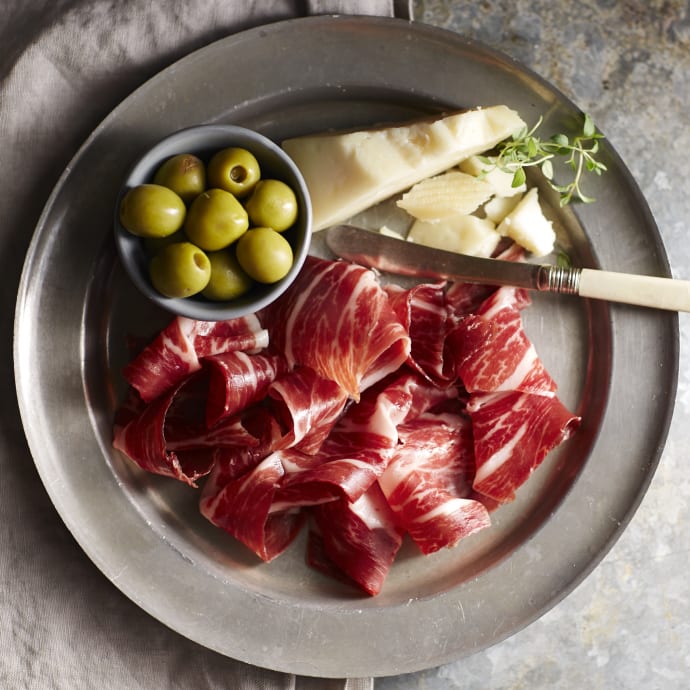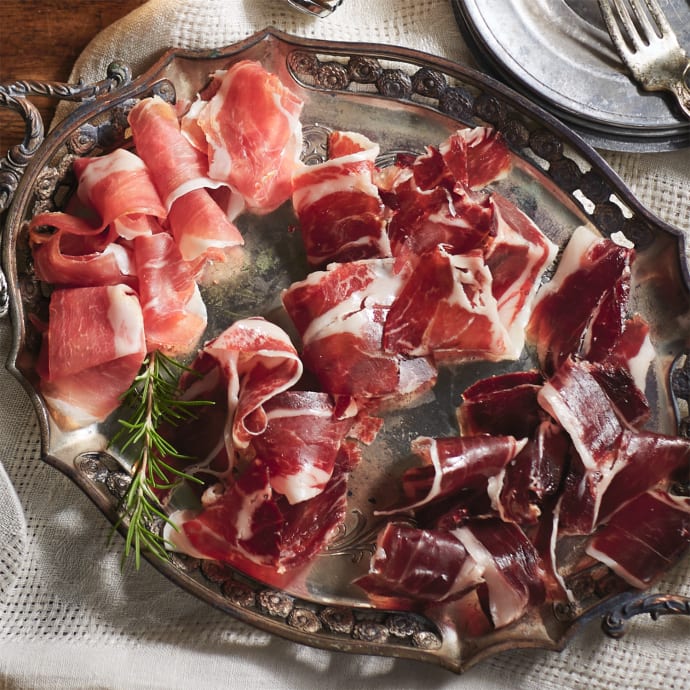
The Most Delicious Ham in the World*
Departures Magazine
-
February 1, 2005
*is not available in the U.S. Yet
Arthur Lubow
The oak-stippled hills of western Spain resemble the world's most scenic wine regions—Napa Valley, Chianti, Burgundy—with just one element missing: the vineyards. The landscape is so picturesque that it might be mistaken for a gigantic park. However, should you drive from Huelva in western Andalusia north to Salamanca in the late fall or winter, you would eventually spot the economic underpinning of these woodland pastures. That black, bristled, stocky animal snuffling through the undergrowth in a ceaseless, gluttonous quest for acorns is the ibérico pig, the scion of an ancient race that has survived unchanged for two millennia. Perfectly adapted to its climate and terrain, this pedigreed swine is the source of the finest ham in the world.
Actually, the aficionados of jamón ibérico would rather you didn't think of their beloved ham as, well, as a ham. For instance, when I mentioned to Rafael Ansón, the president of the Spanish Society for Gastronomy, that the best jamón ibérico goes for upwards of $80 a pound in Madrid and that such a price may strike most Americans as being high for ham, he replied, "What is the cost of white truffles? A pound of beluga caviar? Ibérico ham is a bargain." I got a similar reaction when I asked Miguel Ullibarri, the manager of the ibérico ham producers' trade group, Real Ibérico, to explain what distinguishes jamón ibérico from Parma prosciutto or Spanish jamón serrano. "We never compare ibérico ham with other hams," he told me in a gently admonitory tone. "I love Parma ham and jamón serrano on some occasions, but they are not competitors of jamón ibérico."
Still unobtainable in the United States, ibérico ham really deserves a category of its own. The delicacy's uniqueness was memorably revealed to me during a dinner at El Bulli, the temple of avant-garde cuisine on the Costa Brava, about an hour and a half's drive from Barcelona. We were served, as one of nearly 40 small courses, what appeared to be cherries covered in white chocolate. One bite revealed our error: These cherries had been dipped in the fat of ibérico ham. Delicious! The fat was earthy, nutty, and delicately perfumed. "I love a lot the complexity of the ham," the chef, Ferran Adrià, later explained. "Normally the Americans and the French don't like it, and the Italians cut away the fat. It's a cultural thing. It's very Spanish."
That's true—but whatever the pork-loving advantages of growing up on the Iberian peninsula, sophisticated palates of any nationality recognize the ham's virtues. The illustrious, archetypally French chef Joël Robuchon informed me flatly in Paris, "The ham and pork of Spain are the best in the world." (We were speaking at the L'Atelier de Joël Robuchon, his idiosyncratic—and mobbed—version of a sushi or tapas bar, where a plate of unadorned jamón ibérico is the most expensive dish on the menu.) In New York the telegenic Mario Batali recently opened Bar Jamón, which features Spanish tapas. Because of import restrictions, Bar Jamón can serve only jamón serrano, a cousin of jamón ibérico. Still, serrano is more than respectable. Chef Andy Nusser, who runs the kitchen at Bar Jamón, says that serrano ham is superior to prosciutto from Parma. However, he readily admits, "Once you taste ibérico, you can't compare it to anything else."
A slice of the best jamón ibérico is dark pink or purple in color, suffused with veins of yellowish-white fat. At a tasting arranged for me in Madrid, at the fine traditional restaurant Príncipe de Viana, whole bone-in hams from five regions were lined up. Three came from the areas that, much in the way wines receive regional certification, have won Denominaciónes de Origen accreditation (Huelva, Guijuelo, and Dehasa de Extremadura), while two were from regions with applications pending for the D.O. (Sierra de Sevilla and Los Pedroches de Córdoba). Ansón, who had arranged the event, demonstrated the method for judging an ibérico ham. First, place your nose up close to assess the complexity of the aroma. Then rub your finger on the oleaginous exterior: The fat should be light, not thick and greasy. The visual examination, for depth of color and a glistening surface, is a third test. Finally, you get to taste. At room temperature (the way it should always be eaten) the fat melts in your mouth. The flavor? In a fine ibérico ham, it's as subtle and multileveled as a great wine. During the tasting that afternoon I preferred the offering from the Extremadura. However, what we were really determining wasn't superiority but subtle regional differences: For instance, the hams from Seville and Córdoba tasted brinier.
By consensus, the best ham maker in Spain is Joselito, a company based at the northern, colder edge of the range, near Salamanca in Guijuelo. Both Adrià and Robuchon serve Joselito ham in their restaurants. So does Juan Mari Arzak, Spain's most venerated older chef, and Andoni Luis Aduriz, the most talented younger chef in the nation, at their establishments (Arzak and Mugaritz, respectively) in the Basque Country. "The quality is unbeatable," Arzak says. Rafael García Santos, the highly influential Spanish food critic, rates the Joselito Gran Reserva at 9.75 out of a possible 10—which in his view makes it the best food product of any kind in the country.
Seeking insight into the mysteries of jamón ibérico, I enlisted the men who run Joselito, a fifth-generation family firm: José Gómez, the company CEO, who oversees the curing plant; his brother Juan Luis Gómez, who supervises the farms; and Germán Arroyo, the export manager. I started at the source, with the pigs, and I visited them during the montanera, the six-month period when they roam the woods, gorging on acorns. By the time they commence this final feast, the pigs are about two years old. At Joselito and the other best brands (notably, Sánchez Romero Carvajal of Jabugo), the breed of pig is pure ibérico; however, less-traditional companies have begun interbreeding the old race with modern varieties that fatten up faster and produce more piglets. Government regulations allow manufacturers to call any pig an ibérico if its parentage is at least three fourths from the ibérico breed. Although some types of pure ibérico pigs are red, golden, or spotted, most are black with black hoofs (which are included in the whole ham)—the reason that pata negra has become a synonym for ibérico.
The montanera is the critical point in the process. It's the pigs' diet that sets apart jamón ibérico from other hams; in fact, the breed is important primarily because—athletic, drought-tolerant, long-legged—it is accustomed to eating very little during the dry summer and devouring as much as 20 pounds of acorns daily in winter. At the start of the montanera, the pigs are very hungry. "To fill the bottle, first it has to be empty," Juan Luis Gómez says. Watching these pigs forage is a fascinating experience. In the wooded pastureland, called the dehesa in Spanish, the two most common trees are the holm oak and the cork oak. The holm acorn is sweeter. In early winter the pigs disdain the acorns of the cork oak, leaving them to litter the forest floor. Instead, they root through the underbrush with their pointed snouts and inhale the holm acorns, crunching down on them and letting the shells fall to the ground. Later in the season they will return to the rejects and scarf them up. As a result of this gluttony, a pig can easily gain a pound and a half a day, until it finally tips the scales at 360 to 400 pounds. To ensure an adequate supply of acorns for such binges, each pig must have about four acres of the dehesa. This factor is what keeps the price of the best jamón ibérico so high and the production so low.
There are indeed lesser forms of jamón ibérico, made from pigs that haven't consumed so many acorns. The highest category—jamón ibérico de bellota, "bellota" being Spanish for acorn—comes from animals that have put on at least one third of their weight by eating nothing but foraged acorns and grass (and the occasional snake) during the montanera. Ibérico pigs with a diet less heavy in acorns are classified as recebo; if they have eaten solely cereals, pienso. In an average year, there will be 4.5 million ibérico hams, but only one tenth of them are bellota. Even among the bellota hams, Joselito separates the largest and best shaped, distinguishing them as Reserva hams. Because the acorn crop varies each year depending on rainfall, ibérico ham is as vintage-dependent as wine. "The worst acorn crop of my life was in 2000," José Gómez says. "Forty percent of Joselito hams were put out under the second label, C. Jota."
The acorn-rich diet transforms the fat of jamón ibérico de bellota. Studies from the University of Extremadura indicate that more than half the ham's fat content is monounsaturated (the type that is in olive oil) rather than the artery-clogging saturated kind usually found in animals. Significantly, at room temperature the ham's fat virtually melts, like a vegetable oil. "When the pig is slaughtered, an analysis of the fat is done," Real Ibérico's Ullibarri explains. "You can see the correlation between the amount of acorns eaten and the percentage of oleic acid—which melts at room temperature—in the fat of the animal."
At Joselito, salting, curing, and aging are done as they have been for centuries. In the factory in Guijuelo, the only mechanical contraption is a button that opens or closes the windows in the drying rooms to regulate the temperature. In the winter, following the slaughter, the hams are piled up and kept in hills of sea salt for nine days. The smaller the ham and the colder the weather, the less salt is required. "We try to use the minimum amount of salt," José Gómez says. "Salt makes the curing process quick, but a ham with a lot of salt, if you keep it for a long time, becomes heavy like concrete." The salt is then washed off, though some has already entered the meat, and for the next three months it migrates inward to the bone. "We need a cold and dry period," Gómez says. "Then comes the curing, when the white fat turns to yellow, in summer. We also need an in-between period in the spring, when the ham adapts to the heat of summer."
Curing takes nine months. After the first 30 days, the hams are covered with a blue-gray patina of mold. "A normal customer in the shop, if he saw the mold on the ham, he would throw it in the dustbin," Gómez says. "But this is what gives it an aroma." In the summer, as the hams sweat off the fat, the odor of the mold penetrates the meat. (From the time of slaughter to sale, the hams lose a third of their weight.) In modern facilities, like the Jabu plant that Joselito owns in Jabugo, technology has been harnessed to reproduce the temperature and humidity of the seasons. At the top-of-the-line plant in Guijuelo, however, nature is permitted to call the shots. Depending on their size (big hams are aged longer), the hams spend 18 to 20 months in the drying rooms. José Gómez says that a large Joselito ham can be kept for seven years. I can't attest to that, but he did serve me one from 1999. Deep purple with striations of yellow fat, it was redolent of the nutty flavor of acorns. Almost five years old, the ham was still in its prime.
Because no Spanish slaughterhouses conform to U.S. Department of Agriculture regulations, jamón ibérico is unavailable in the States. (Outside Spain, the ham is for sale in many of Europe's best food shops; see "Where to Find It.") Jamón serrano can be imported and sold here if the pigs have been butchered in Holland or Denmark before the hams are cured in Spain. Jamón ibérico de bellota, though, must be produced entirely in Spain: The ibérico pig and the dehesa's acorns are essential to its unique flavor.
The good news is that COVAP, a cooperative of 10,000 farmers in Córdoba, has built a new slaughterhouse in the town of Pozoblanco, designed to gain the USDA's approval. Donald B. Harris, the owner of the Virginia-based La Tienda import firm, has toured the plant and plans to bring COVAP's ibérico products into the United States. First will come the sausages (chorizo, salsichón, lomo) that are made from other parts of the pig and demand less time to cure—they may be obtainable by early 2006. Harris hopes the first ibérico hams will arrive in 2007.
Ibérico ham is best eaten unembellished. Ideally it is placed on a special stand and the carver uses a long, sharp knife to cut paper-thin slices. "Anything you do with this product is going to make it worse," Ullibarri says. "For chefs, it's a bit of a problem." The best chefs have the self-confidence to present it naked. The only decision remaining, then, is what beverage to serve with the delicacy. To culminate our Madrid tasting of five hams, Rafael Ansón raided his capacious cellar and offered ten candidates. Among them were such rarities as a 200-year-old solera sherry and a 1982 Mouton Rothschild ("the best Mouton of the century," Ansón said proudly). The winners were far humbler. The dozen of us at the tasting judged a chilled fino sherry as the best, and a young red wine—what Spaniards call a tinto crianza—as the runner-up. Both wines were able to cut the unctuous richness of the ham. In a sense we had rediscovered the wheel, as these are the traditional accompaniments to jamón ibérico. That simple wines work best with ibérico ham comes as no surprise. "Thirty years ago this was a poor people's product," Ullibarri observes. "It's what was available in those areas. It's what people ate for energy." Like black truffles, which Provençal peasants once dug from the woods for free, what was yesterday beneath notice is today beyond praise.
Other Press
The Winter Travel Shortlist: Problem-Solving Essentials I’m Packing This Season
Forbes
-
November 20, 2025
54 Gifts for People Who Have Everything
Wirecutter
-
November 6, 2025
What Andrew Zimmern Can’t Live Without
The Strategist
-
June 30, 2025
8 Tasty Ways To Travel The World With Food
Forbes
-
June 17, 2025
Featured Products
 SHIPS FREE
SHIPS FREECinco Jotas Bone-In 100% Ibérico de Bellota Jamón - FREE SHIPPING!
JM-106
(4)
$1,599.00$1,599.00
 SHIPS FREE
SHIPS FREEBone-In Jamón Ibérico Ham by Fermín - FREE SHIPPING!
JM-11
(9)
$799.00$799.00
 SHIPS FREE
SHIPS FREEBoneless Jamón Ibérico Ham by Fermín - FREE SHIPPING!
JM-12
$799.00$799.00
 BEST SELLER
BEST SELLERSliced Ibérico Ham by Peregrino, Nitrate Free - 2 oz
JM-23
(38)
$28.00$28.00
 BEST SELLER
BEST SELLERJamón Tasting Trio of Sliced Ham
JM-25
(36)
$85.00$85.00
 BEST SELLER
BEST SELLERCured Meats of Spain Sampler
JM-45
(38)
$109.00$109.00
 BEST SELLER
BEST SELLERSliced Ibérico de Bellota Ham by Peregrino, Nitrate Free - 2 oz
JM-52
(47)
$42.00$42.00







